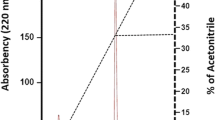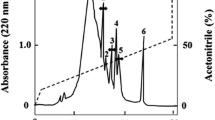Abstract
Lactobacillus curvatus L442, isolated from Greek traditional fermented sausage prepared without the addition of starters, produces a bacteriocin, curvaticin L442, which is active against the pathogen Listeria monocytogenes. The bacteriocin was purified by 50% ammonium sulphate precipitation, cation exchange, reverse phase and gel filtration chromatography. Partial N-terminal sequence analysis using Edman degradation revealed 30 amino acid residues, revealing high homology with the amino acid sequence of sakacin P. Curvaticin L442 is active at pH values between 4.0 and 9.0 and it retains activity even after incubation for 5 min at 121 °C with 1 atm of overpressure. Proteolytic enzymes and α-amylase inactivated this curvaticin, while the effect of lipase was not severe.
Similar content being viewed by others
References
Altschul S.F., Gish W., Miller W., Myers E.W., Lipman D.J. (1990). Basic local alignment search tool. J. Mol. Biol. 215:403–410
Aymerich M.T., Garriga M., Monfort J.M., Nes I., Hugas M. (2000). Bacteriocin producing lactobacilli in Spanish-styled fermented sausages: characterization of bacteriocins. Food Microbiol. 17:33–45
Barefoot S.F., Klaenhammer T.R. (1983). Detection and activity of lactacin B, a bacteriocin produced by Lactobacillus acidophilus. App. Environ. Microbiol. 45:1808–1815
Bredholt S., Nesbakken T., Holck A. (1999). Protective cultures inhibit growth of Listeria monocytogenes and Escherichia coli O157:H7 in cooked, sliced, vacuum- and gas-packaged meat. Int. J. Food Microbiol. 53:43–52
Casla D., Requena T., Gomez P. (1996). Antimicrobial activity of lactic acid bacteria isolated from goat’s milk and artisanal cheeses: characteristics of a bacteriocin produced by Lactobacillus curvatus IFPL105. J. Appl. Bacteriol. 18:35–41
Daeschel M.A. (1989). Antimicrobial substances from LAB for use as food preservatives. Food Technol. 1:164–167
De Vuyst L., Vandamme E.J. (1994). Antimicrobial potential of lactic acid bacteria. In: De Vuyst L., Vandamme E.J. (eds) Bacteriocins of lactic acid bacteria: Microbiology, Genetics and Applications. Blackie Academic and Professional, London, United Kingdom, pp. 91–142
De Vuyst L., Callewaert R., Pot B. (1996) Characterization of the antagonistic activity of Lactobacillus amylovorus DCE 471 and the large- scale isolation of the bacteriocin amylovorin L471. Syst. Appl. Microbiol. 19:9–20
Ennahar S., Sashihara T., Sonomoto K., Shizaki A. (2000). Class II a bacteriocins: biosynthesis, structure and activity. FEMS Microbiol. Rev. 24:85–106
Ferchichi M., Frere J., Mabrouk K., Manai M. (2001). Lactococcin MMFII, a novel class IIa bacteriocin produced by Lactococcus lactis MMFII, isolated from a Tunisian diary poduct. FEMS Microb. Lett. 20:44–45
Garver K.I. and Muriana P.M. (1994). Purification and partial amino acid sequence of curvaticin FS47, a heat stable bacteriocin produced by Lactobacillus curvatus FS47. Appl. Environ. Microbiol. 60:2191–2195
Grau F.H., Vanderlinde P.B. (1990). Growth of Listeria monocytogenes on vacuum-packaged beef. J. Food Prot. 53:739–741
Guyonnet D., Fremaux C., Cenatiempo Y., Berjeaud J.M. (2000). Method for rapid purification of class II a bacteriocins and comparison of their activities. Appl. Environ. Microbiol. 66:1744–1748
Hammes W.P., Bantleon A., Min S. (1990). Lactic acid bacteria in meat fermentation. FEMS Microbiol. Rev. 87:165–174
Holck A., Axelsson L., Birkeland S.E., Aukrust T., Blom H. (1992). Purification and amino acid sequence of sakacin A, a bacteriocin from Lactobacillus sakei Lb706. J. General Microbiol. 138:2715–2720
Holck A., Axelsson L., Huhne K., Krockel L. (1994). Purification and cloning of sakacin 674, a bacteriocin from Lactobacillus sakei Lb674. FEMS Microbiol. Lett. 115:143–150
Hugas M., Garriga M., Aymerich T., Monfort J.M. (1993). Biochemical characterization of lactobacilli from dry fermented sausages. Int. J. Food Microbiol. 18:107–113
Klaenhammer T.R. (1993). Genetics of bacteriocins produced by lactic acid bacteria. FEMS Microbiol. Rev. 12:39–86
Leroy F., De Vuyst L. (1999). Temperature and pH conditions that prevail during fermentation of sausages are optimal for production of the antilisterial bacteriocin sakacin K. Appl. Environ. Microbiol. 65:974–981
Leroy F., De Vuyst L. (2000). Sakacins. In: Naidu N (ed) Natural Antimicrobial Systems. CRC Press, Boca Raton, USA, pp. 589–610
Lücke F.-K. (2000) Fermented meats. In: Lund B., Baird-Parker A., Gould G.W. (ed) The microbiological safety and quality of foods. Aspen Publication, Maryland, pp. 420–444
Lowry O.H., Rosebrough N.J., Farr A.L., Randall R.J. (1951) Protein measurement with the Folin phenol reagent. J. Biol. Chem. 193:265–276
Lozano J.C.N., Nissen-Meyer J., Sletten K., Pelaz C., Nes I.F. (1992) Purification and amino acid sequence of a bacteriocin produced by Pediococcus acidilactici. J. Gen. Microbiol. 138:1985–1990
McClure P.J., Roberts T.A., Ottooguru P. (1989). Comparison of the effects of sodium chloride, pH and temperature on the growth of Listeria monocytogenes on gradient plates and liquid medium. Lett. Appl. Microbiol. 9:95–99
Mataragas M. 2003. Biochemical characterization of bacteriocins produced by lactic acid bacteria and study of their application for the preservation of fresh meat and its products. Ph.D. Thesis, Department of Food Science and Technology, Agricultural University of Athens. p. 58.
Messens W., Verluyten J., Leory F., De Vuyst L. (2003). Modelling growth and bacteriocin production by Lactobacillus curvatus LTH 1174 in response to temperature and pH values used for European sausage fermentation processes. Int. J. Food Microbiol. 81:41–52
Muriana P.M. 1996. Bacteriocins for control of Listeria spp. in food. J. Food Prot. Suppl. 54S–63S.
Muriana P.M., Klaenhammer T.R. (1991). Purification and partial characterization of lactacin F, a bacteriocin produced by Lactobacillus acidophilus 11088. Appl. Environ. Microbiol. 57:114–121
Nes I.F., Holo H. (2000). Class II antimicrobial peptides from lactic acid bacteria. Biopolymers. 55:50–61
Nissen-Meyer J., Holo H., Havarstein L.S., Sletten K., Nes I.F. (1992). A novel lactococcal bacteriocin whose activity depends on the complementary action of two peptides. J. Bacteriol. 174:5686–5692
Palumbo S. (1986). Is refrigeration enough to restain foodborne pathogens?. J. Food Prot. 49:1003–1009
Parish M.E., Higgins D.P. (1989). Survival of Listeria monocytogenes in low pH model broth system. J. Food Prot. 52:144–147
Piard J.C., Desmazeaud M. (1992). Inhibiting factors produced by lactic acid bacteria. Bacteriocins and other antibacterial substances. Lait 72:113–142
Roca M., Inche K. (1990). Fermented sausages. Food Rev. Int. 6:91–118
Schägger H., von Jagow G. (1987). Tricine-sodium dodecyl sulphate-polyacrilamide gel electrophoresis for the separation of proteins in the range of 1 to 100 kDa. Anal. Biochem. 166:368–379
Schillinger U., Kaya M., Lücke F.K. (1991). Behaviour of Listeria monocytogenes in meat and its control by a bacteriocin-producing strain of Lactobacillus sakei. J. Appl. Bacteriol. 70: 473–478
Schillinger U., Lücke F.K. (1989). Antibacterial activity of Lactobacillus sakei isolated from meat. Appl. Environ. Microbiol. 55:1901–1906
Simon L., Fremaux C., Cenatiempo Y., Berjeaud J.M. (2002) Sakacin G, a new type of antilisterial bacteriocin. Appl. Environ. Microbiol. 68:6416–6420
Sobrino O.J., Rodriguez J.M., Moreira W.L., Fernandez M.F., Sanz B., Hernanzed P.E. (1992) Sakacin M, a bacteriocin-like substance from Lactobacillus sakei 148. Int. J. Food Microbiol. 16:215–225
Suridman I., Mathieu F., Lefebvre G. (1993) Detection and properties of curvaticin-13, a bacteriocin like substance produced by Lactobacillus curvatus SB13. Curr. Microbiol. 27:35–40
Stiles M.E., Holzaphel W.H. (1997) Lactic acid bacteria of foods and their current taxonomy. Int. J. Food Microbiol. 36:1–29
Tichaczek P.S., Nissen-Meyer J., Nes I.F., Vogel R.F., Hammes W.P. (1992) Characterization of the bacteriocin curvacin A from Lactobacillus curvatus LTH1174 and sakacin P from Lactobacillus sakei LTH673. Syst. Appl. Microbiol. 15:460–468
van Belkum M.J., Kok J., Venema G. (1992) Cloning, sequence, and expression in Escherichia coli of lcnB, a third bacteriocin determinant from the lactococcal bacteriocin plasmid p9B4–6. Appl. Environ. Microbiol. 58:572–577
Vignolo G., Fadda S., de Kairuz M.N., de Ruiz Holgado A.A.P., Oliver G. (1996) Control of Listeria monocytogenes in ground beef by Lactocin 705 a bacteriocin produced by Lactobacillus casei CRL 705. Int. J. Food Microbiol. 29:397–402
Author information
Authors and Affiliations
Corresponding author
Rights and permissions
About this article
Cite this article
Xiraphi, N., Georgalaki, M., Driessche, G.V. et al. Purification and characterization of curvaticin L442, a bacteriocin produced by Lactobacillus curvatus L442. Antonie Van Leeuwenhoek 89, 19–26 (2006). https://doi.org/10.1007/s10482-005-9004-3
Received:
Accepted:
Published:
Issue Date:
DOI: https://doi.org/10.1007/s10482-005-9004-3




